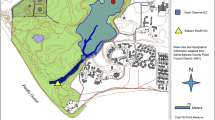Abstract
Mummichog,Fundulus heteroclitus, were collected weekly from a southern New Jersey high-salinity salt marsh from October 1988 to June 1989 and from September 1989 to June 1990 to determine the overwintering habitat. Major habitat types sampled within the salt marsh were subtidal creek, intertidal creeks, and salt-marsh pools. Few individuals were collected in the intertidal creek or the subtidal creek from the end of October through the beginning of May for both years, when creek water temperatures were low. Both young-of-the-year and adults of both sexes were abundant in the salt-marsh pools (total lengths ranged from 29 mm to 125 mm) throughout the winter. In the spring, catch per unit effort (CPUE) within the tidal creek increased with increasing water temperature, while CPUE in marsh pools decreased with increases in estuarine water temperature. These collection patterns indicate that the majority ofF. heteroclitus may move from subtidal and intertidal creeks into salt-marsh pools in the late fall and leave in the spring. This seasonal movement could explain how fish survive winter environmental conditions because daily average water temperatures of salt-marsh pools were warmer than subtidal creek temperatures for much of the winter.
Similar content being viewed by others
Literature Cited
Able, K. W. 1990. Life history patterns of New Jersey salt marsh killifishes.Bulletin of the New Jersey Academy of Science 35:23–30.
Able, K. W., R. Hoden, D. Witting, andJ. B. Durand. 1992. Physical parameters of the Great Bay-Mullica River Estuary. Institute of Marine and Coastal Sciences, Technical Report No. 92-06, Rutgers University, New Brunswick, New Jersey. 38 p.
Boesch, D. F. andR. E. Turner. 1984. Dependence of fishery species on salt marshes: The role of food and refuge.Estuaries 7:460–468.
Burger, J. 1983. Jamaica Bay Studies II: Effect of tidal, temporal and weather variables on distribution of ibises, egrets, and herons on a coastal estuary.Acta Oecologia 4:181–189.
Chidester, F. E. 1920. The behavior ofFundulus heteroclitus on the salt marshes of New Jersey.American Naturalist 54:551–557.
Crabtree, R. E. andJ. M. Dean. 1982. the structure of two South Carolina estuarine tide pool fish assemblages.Estuaries 5:2–9.
Currin, B. M., J. P. Reed andJ. M. Miller. 1984. Growth, production, food consumption, and mortality of juvenile spot and croaker: A comparison of tidal and nontidal nursery areas.Estuaries 7:451–459.
Fritz, E. S., W. H. Meredith, andV. A. Lotrich. 1975. Fall and winter movements and activity level of the mummichog,Fundulus heteroclitus, in a tidal creek.Chesapeake Science 16:211–215.
Hoff, J. G. andR. M. Ibara. 1977. Factors affecting the seasonal abundance, composition, and diversity of fishes in a New England estuary.Estuarine and Coastal Marine Science 5:665–678.
Lotrich, V. A. 1975. Summer home range and movements ofFundulus heteroclitus (Pisces: Cyprinodontidae) in a tidal creek.Ecology 56:191–198.
Lotrich, V. andW. H. Meredith. 1974. A technique and the effectiveness of various acrylic colors for subcutaneous marking of fish.Transactions of the American Fisheries Society 103:140–142.
Nixon, S. W. andC. A. Oviatt. 1973. Ecology of a New England salt marsh.Ecological Monographs 43:463–498.
Rountree, R. A. 1992. Fish and macroinvertebrate community structure and habitat use patterns in salt marsh creeks of southern New Jersey, with a discussion of marsh carbon export. Ph.D. Dissertation. Rutgers University, New Brunswick, New Jersey. 292 p.
Rountree, R. A. andK. W. Able. 1992. Fauna of polyhaline subtidal marsh creeks in southern New Jersey: Composition, abundance, and biomass.Estuaries 15:171–185.
Rozas, L. P., C. C. McIvor, andW. E. Odum. 1988. Intertidal rivulets and creekbanks: Corridors between tidal creeks and marshes.Marine Ecology Progress Series 47:303–307.
Shenker, J. M. andJ. M. Dean. 1979. The utilization of an intertidal salt marsh creek by larval and juvenile fishes: Abundance, diversity, and temporal variability.Estuaries 2: 154–163.
Talbot, C. W. andK. W. Able. 1984. Composition and distribution of larval fishes in New Jersey high marshes.Estuaries 7:434–443.
Talbot, C. W., K. W. Able, andJ. K. Shisler. 1986. Fish species composition in New Jersey salt marshes: Effects of marsh alterations for mosquito control.Transactions of the American Fisheries Society 115:269–278.
Targett, T. E. 1978. Respiratory metabolism of temperature acclimatedFundulus heteroclitus (L.): Zones of compensation and dependence.Journal of Experimental Marine Biology and Ecology 32:197–206.
Tonn, W. M. 1985. Density compensation inUmbra-Perca fish assemblages of northern Wisconsin lakes.Ecology 66:415–429.
Author information
Authors and Affiliations
Rights and permissions
About this article
Cite this article
Smith, K.J., Able, K.W. Salt-marsh tide pools as winter refuges for the mummichog,Fundulus heteroclitus, in New Jersey. Estuaries 17, 226–234 (1994). https://doi.org/10.2307/1352572
Received:
Accepted:
Issue Date:
DOI: https://doi.org/10.2307/1352572




